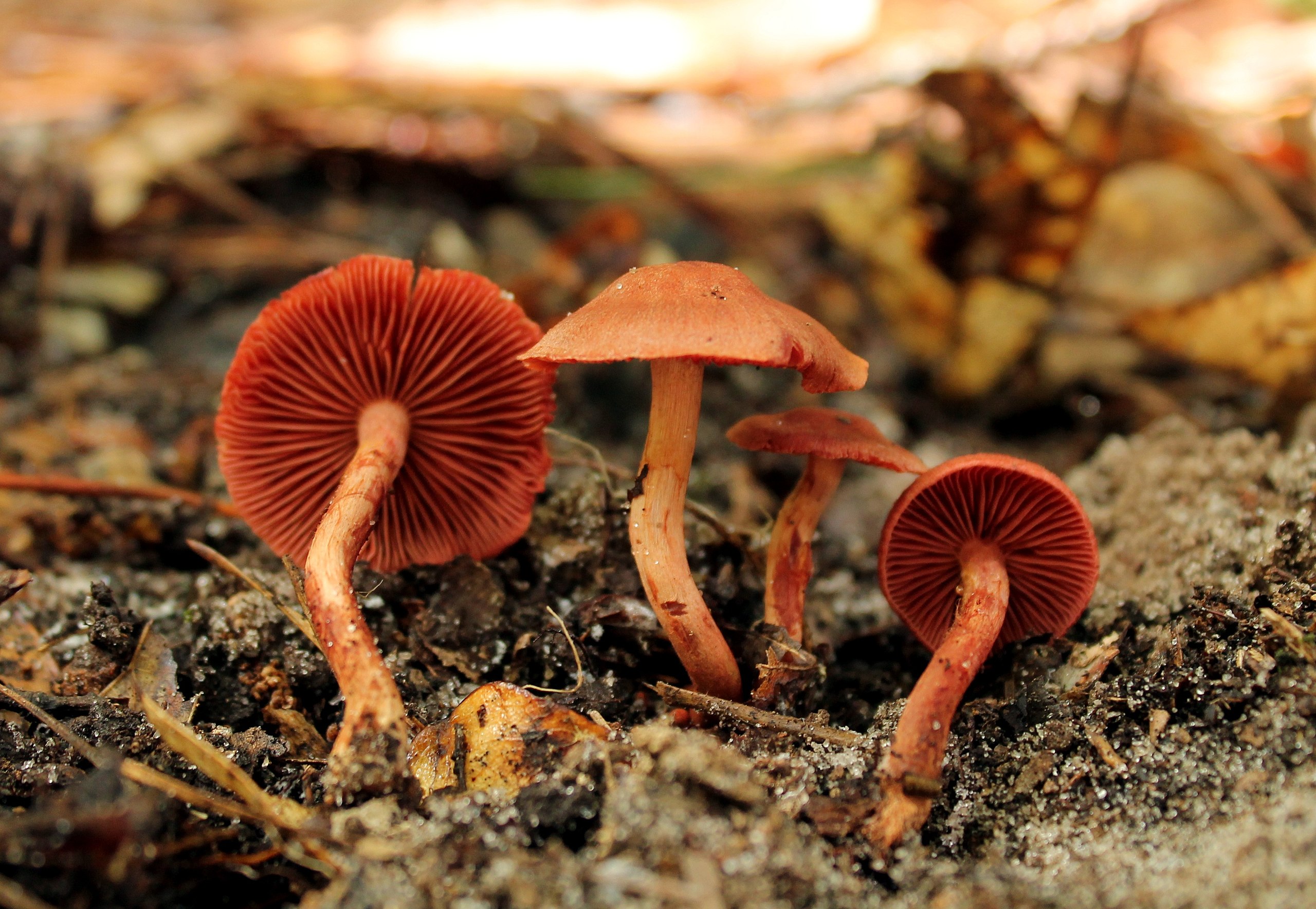In your backyard or lawn, it’s possible for red mushrooms to suddenly appear as if out of nowhere. These fungi, with their vibrant red hues, can sprout overnight, forming clusters of dark orange, deep red, or bright red spongy growths. Red mushrooms, or toadstools, are particularly captivating due to their striking colors and unique shapes.
However, it’s crucial to note that while they may be visually appealing, many types of red mushrooms found in your yard can be highly toxic. For instance, the fly agaric (Amanita muscaria) is a vividly colored mushroom with a red cap and white spots. This iconic red and white toadstool contains toxins that can lead to severe health complications if ingested.
Despite the toxicity of numerous red-capped mushrooms, there are some species that are safe for consumption. Red chanterelles (Cantharellus cinnabarinus) and ox tongue mushrooms (Fistulina hepatica) are two examples of edible red mushrooms.
It’s important to clarify that this article’s sole purpose is to provide information. It serves as a visual guide to various species of red mushrooms, without indicating whether they are edible or teaching you how to cook them. Eating any type of mushroom without correctly identifying its species can be dangerous.
This article aims to assist in identifying different types of primarily red mushrooms. Some of these mushrooms can be found in grassy areas of your yard, while others are more commonly found in forests and woodlands.
Red Mushrooms in the Lawn
It’s easy to spot red mushrooms growing amidst the grass on your lawn. Their red hues stand out against the dark green blades of grass. Examples of common red mushrooms found in lawns include the basket stinkhorn (Clathrus ruber), the red starfish stinkhorn (Aseroe rubra), and the Octopus stinkhorn (Clathrus archeri).
However, it’s more typical to find white mushrooms in lawns, yards, and cultivated soil. Red mushrooms are more likely to appear along the edges of lawns, particularly in areas shaded by trees or shrubs with dense foliage. If you come across red mushrooms in your lawn, it’s best to identify the specific species before deciding how to proceed.
Why Mushrooms Grow in the Yard
Like all mushrooms, red mushrooms flourish in yards under ideal conditions. They thrive in soil rich in organic matter, with sufficient moisture and shade. Consequently, you’re more likely to find red mushrooms in your yard during late summers and fall, following heavy rainfall and warm temperatures.
The presence of red mushrooms in your front or backyard shouldn’t be a cause for concern. Mushrooms are the visible fruiting bodies of fungi in the soil, indicating healthy ground. This means that the shrubs, plants, turfgrass, and trees in your yard possess adequate nutrients.
How to Identify Red Mushrooms
Red mushrooms possess several distinguishing characteristics that aid in identification. These include size, shade of red, cap scales, stem and cap shape, as well as the presence of gills, teeth, or pores under the cap. Some mushrooms also emit an earthy or musty odor, aiding in identification.
Several types of edible mushrooms share common identifying traits. These include brown or tan gills, caps without scales, and stems lacking a ring. Unfortunately, many red mushrooms are inedible. Therefore, it’s crucial never to forage for mushrooms without the guidance of an experienced expert. Mistaking a poisonous mushroom for an edible species can result in mushroom poisoning.
According to the Indiana Department of Health, “proper identification of wild mushroom species requires advanced studies in the field of mycology, in addition to considerable foraging and identification experience in the field.”
Types of Red Mushrooms (With Pictures) – Identification Guide
Now let’s delve into more detail about various common mushroom varieties exhibiting red, reddish-brown, orange-red, or pinkish-red colors. Some of these varieties are likely to grow in your lawn or backyard.
Fly Agaric — Red Mushroom With White Spots (Amanita muscaria)
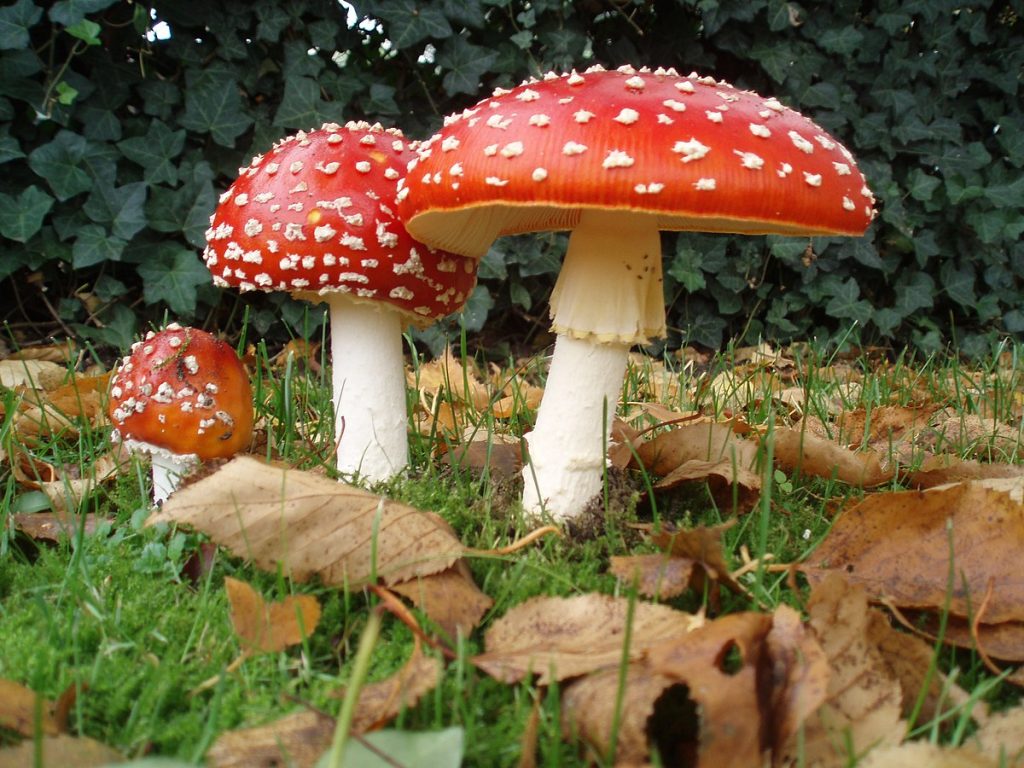
The poisonous fly agaric mushroom, also known as fly amanita, is recognizable by its red cap adorned with white specks. It has a short white stem, white gills, white flesh, and an oval or round dark orange to red cap with whitish warts.
Fly agaric mushrooms grow between 2.7 and 7 inches (7 to 18 cm) tall, with caps ranging from 2.7 to 8.2 inches (7 to 21 cm) in diameter. Typically, you’ll find these toxic red mushrooms in woodlands near conifers and birch trees.
Red mushroom identification
Fly agaric mushrooms can be easily identified by their rounded or oval red caps covered in small, cottony white growths.
Ringless False Fly Amanita Mushroom (Amanita parcivolvata)
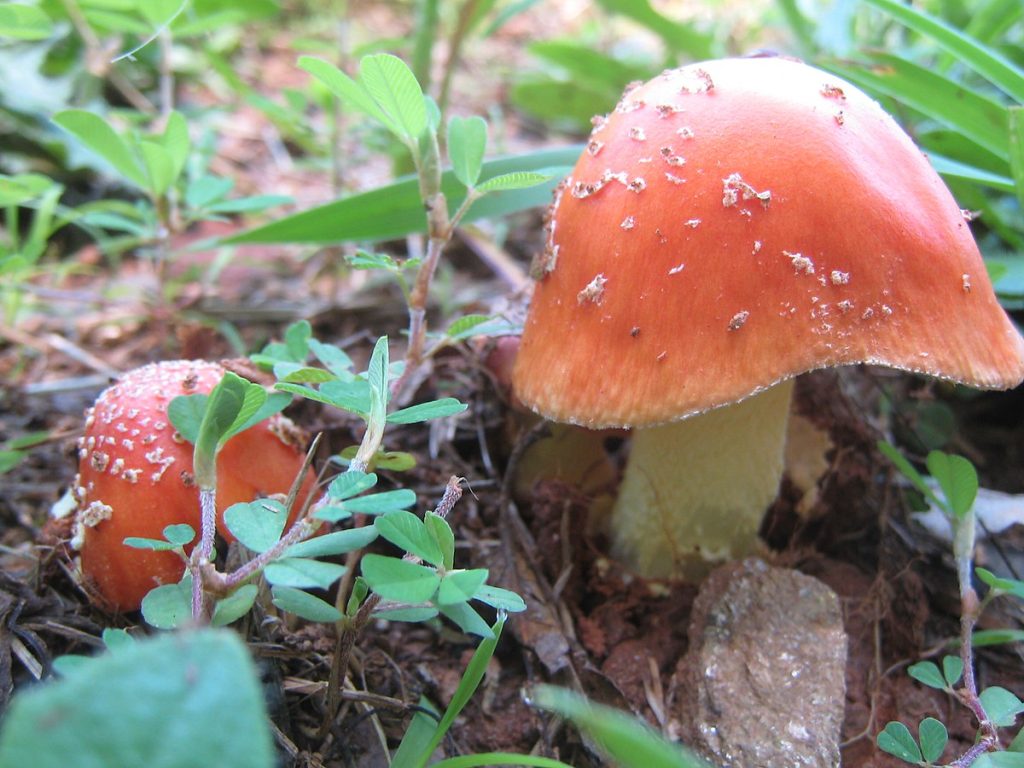
The ringless false fly amanita mushroom exhibits a deep orange to red rounded or oval cap with several white warts. In contrast to the red and white fly agaric toadstool, this red and white mushroom features a slender white stem. Its reddish-orange cap conceals pale yellow gills.
With a slender cylindrical white stem, the ringless false fly amanita grows between 1.5 and 4.7 inches (4 to 12 cm) tall. Its convex or flat reddish cap measures 1.1 to 2.7 inches (3 to 7 cm) in diameter.
Red mushroom identification
The ringless false fly amanita can be identified by its orangey-red cap and slender, pure white stem.
The Sickener Mushroom (Russula emetica)
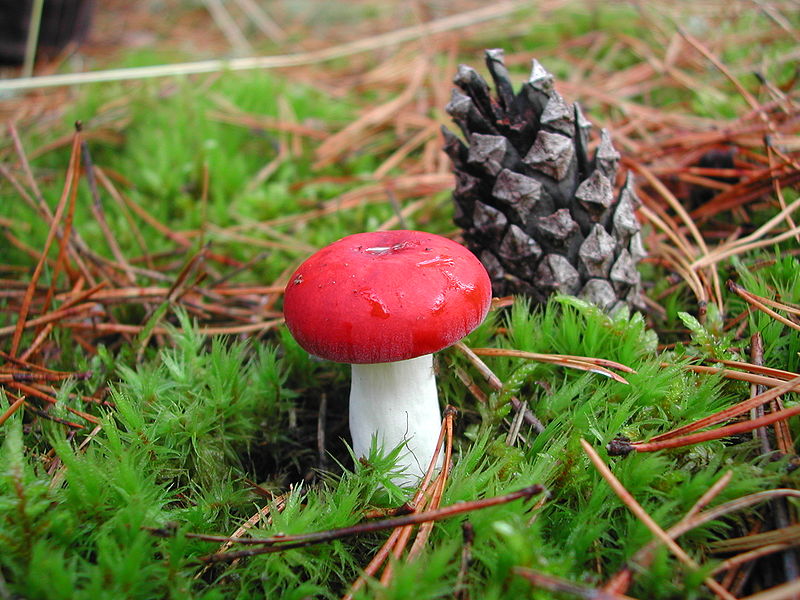
The sickener mushroom boasts a red, oval, flattened cap with a sticky surface. Its evenly spaced white gills lie beneath the red cap, supported by a cylindrical thick white stem. This inedible mushroom typically grows at the foot of coniferous trees and in mixed forests.
As the name suggests, the red sickener mushroom induces gastrointestinal upset if ingested. It is also referred to as the vomiting russula or emetic russula.
Red mushroom identification
The sickener mushroom is distinguished by its smooth, sticky red cap, white stem, and gills. It measures between 1.0 and 3.3 inches (2.5 to 8.5 cm) in width and 1.8 to 4.1 inches (4.5 to 10.5 cm) in height.
Basket Stinkhorn Mushroom (Clathrus ruber)
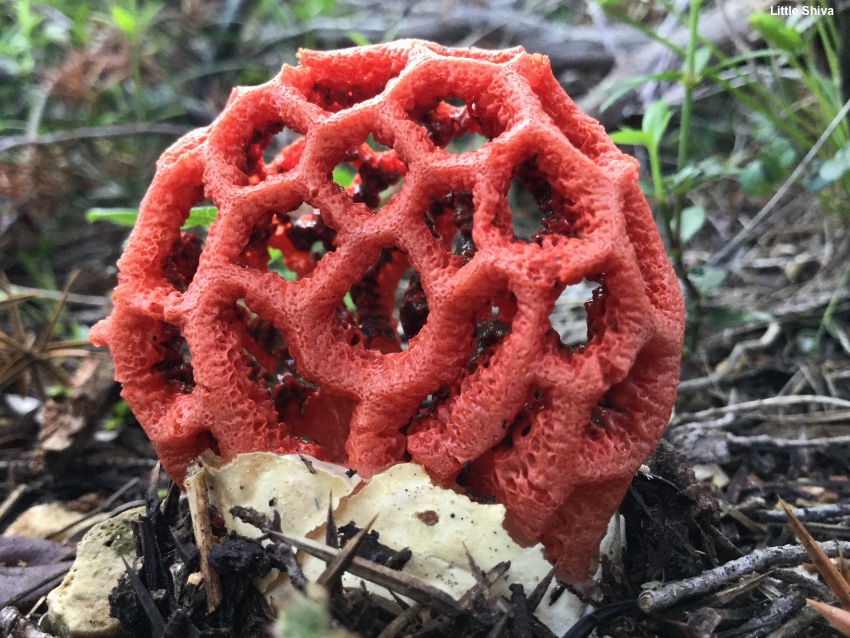
The basket stinkhorn is a peculiar red mushroom found in lawns, backyards, and near woody debris. Its distinctive appearance resembles a round ball with large holes, initially resembling a whitish egg. Once opened, it reveals a bright red to pink fungus consisting of a network of spongy arms.
Measuring up to 2.4 inches (6 cm) in diameter, the basket stinkhorn exhibits a roughly spherical shape.
Red mushroom identification
The easily recognizable basket stinkhorn is a roundish red mushroom composed of spongy latticed arms.
Starfish Fungus (Aseroe rubra)
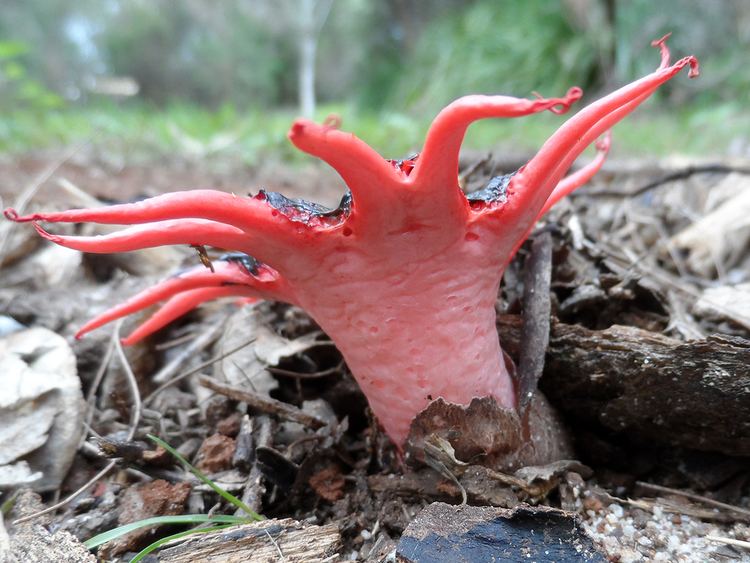
The starfish fungus stands out due to its red, star-shaped structure growing on a pinkish-white stem. Like all stinkhorn mushrooms, this red species emerges
as a white knobby egg, followed by the growth of a pinkish-white stem and eventually red, pink, or orange-colored tentacle-like spongy arms.
The starfish fungus grows about 4 inches (10 cm) tall, with arms measuring up to 1.5 inches (4 cm) in length.
Red mushroom identification
Also known as the anemone stinkhorn, the starfish fungus resembles a red star-shaped entity growing on a pinkish-white stem. Like all stinkhorns, this red species is slimy and emits a foul odor.
Octopus Stinkhorn Mushroom (Clathrus archeri)

The octopus stinkhorn is another reddish fungus commonly found in backyards and lawns. Its red arm-like structures emerge from a white egg, giving it the appearance of a red and white octopus. The mushroom is covered in a stinky goo.
Also referred to as devil’s fingers, the foul-smelling octopus stinkhorn grows up to 4 inches (10 cm) tall, with four to six fruiting red arms emerging from a whitish egg.
Red mushroom identification
The octopus stinkhorn is easily recognizable in lawns or gardens due to its black-spotted red tentacle-like structures.
Jackson’s Slender Amanita Mushroom (Amanita jacksonii)

The Jackson’s slender amanita is a tall, slender mushroom sporting a rounded brilliant red or deep orange convex cap. Older mushrooms display a more distinct orange shading around the edges. Its slender stems are yellow, and the gills under the red cap are orange-yellow. Typically, it is found near oaks and pine trees in late summer and fall.
Although considered edible, this mushroom is easily mistaken for the highly toxic fly amanita. It grows between 3.5 and 6 inches (9 to 15 cm) tall, with a rounded cap measuring 2 to 4.7 inches (5 to 12 cm) in diameter.
Red mushroom identification
The Jackson’s slender amanita is a red mushroom with a red, sticky cap, orange-yellow gills, and a slender, yellowish stem.
Stinky Squid Mushroom (Pseudocolus fusiformis)
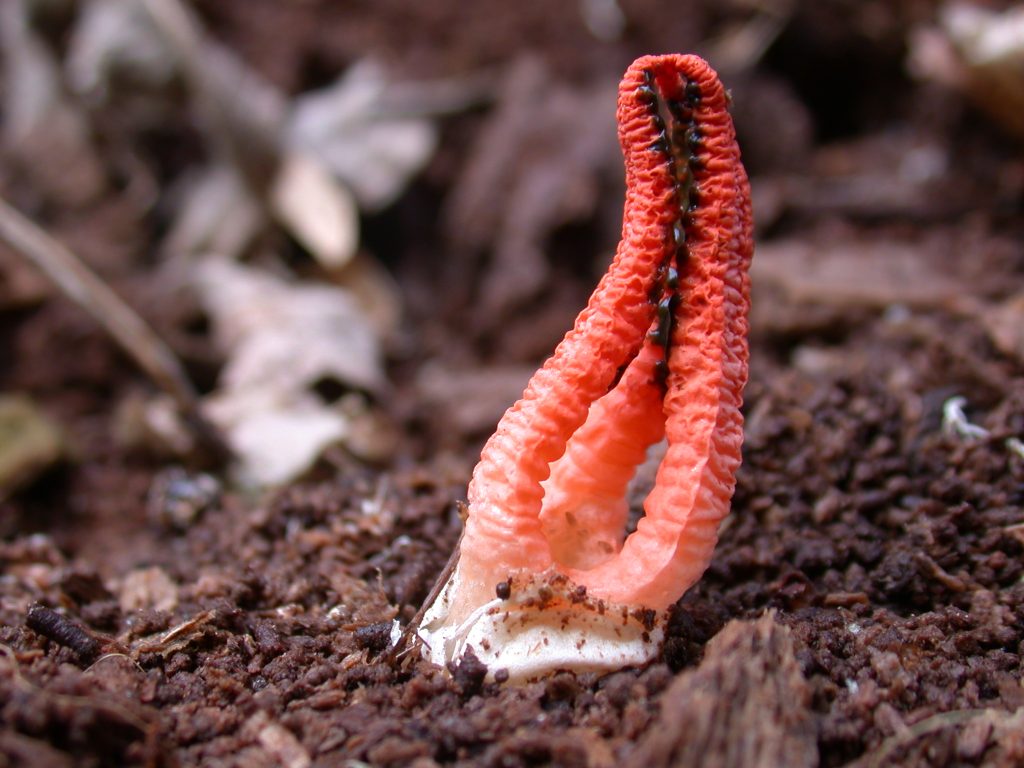
The stinky squid is a small stinkhorn mushroom recognized by three or four tapered orange to pale red arms emerging from a whitish, pear-shaped puffball. What makes this orangey-red mushroom intriguing is how the tapered fruiting bodies join at the top. The stink emitted from the squid mushroom has been compared to pig manure.
Measuring between 1.2 and 2.4 inches (3 to 6 cm) in height, the stinky squid mushroom can be found in lawns, gardens, and woodlands.
Red mushroom identification
The stinky squid mushroom features three or four orange-red arm-like structures growing upward and joining at the tapered end.
Red Chanterelle (Cantharellus cinnabarinus)
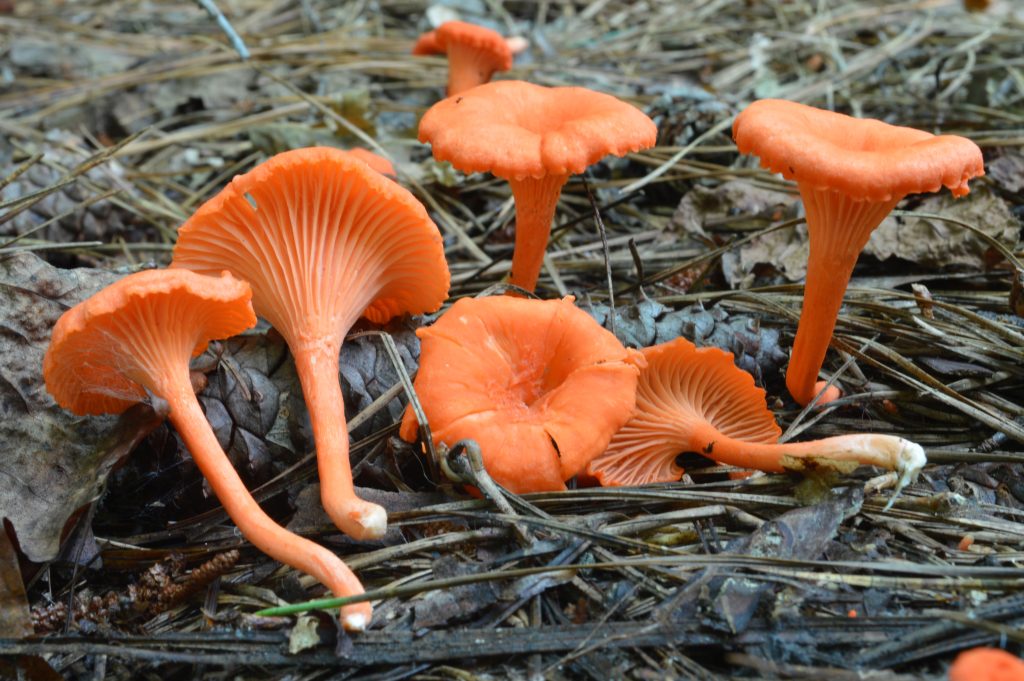
Red chanterelles exhibit distinctive bright red, orange, or flamingo-pink colors. Typically found in broadleaf or mixed forests, these brightly colored red mushrooms have flat caps with a slight depression in the center. The reddish-orange stem is usually slightly curved, with false gills under the cap.
Red chanterelles are small, edible red mushrooms that grow between 0.4 and 1.5 inches (1 to 4 cm) tall. Their smooth caps with curved margins can reach up to 1.5 inches (4 cm) in width.
Red mushroom identification
Small red chanterelle mushrooms are easily distinguished by their bright red color, setting them apart from the related yellow or golden-yellow chanterelle varieties.
Ox Tongue Mushroom (Fistulina hepatica)
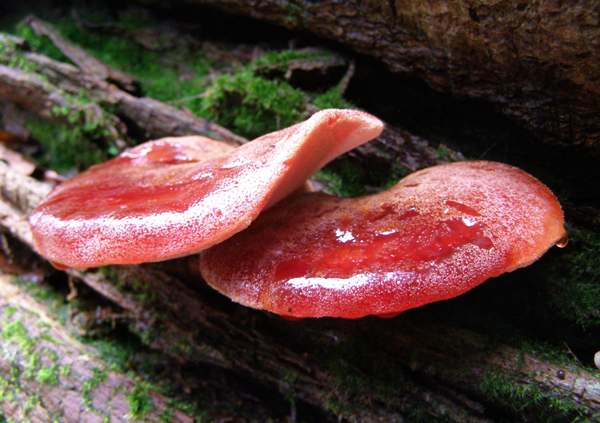
The ox tongue mushroom is a large, flat red mushroom that grows on tree trunks. Resembling an oversized tongue, it has a meaty texture and is also known as mushroom tongue, ox poor man’s steak, and beefsteak fungus. The mushroom contains red liquid resembling blood.
Fistuline hepatica is a type of parasitic fungus found growing on rotting tree stumps, chestnut trees, or oak trees. The large bright red to reddish-brown cap measures between 2.7 and 8 inches (7 to 20 cm) in diameter and up to 5.5 inches (14 cm) in depth.
Red mushroom identification
The ox tongue mushroom, an edible species, is easily identified by its large, flat, thick cap attached to deciduous tree trunks.
Boletus pseudosensibilis
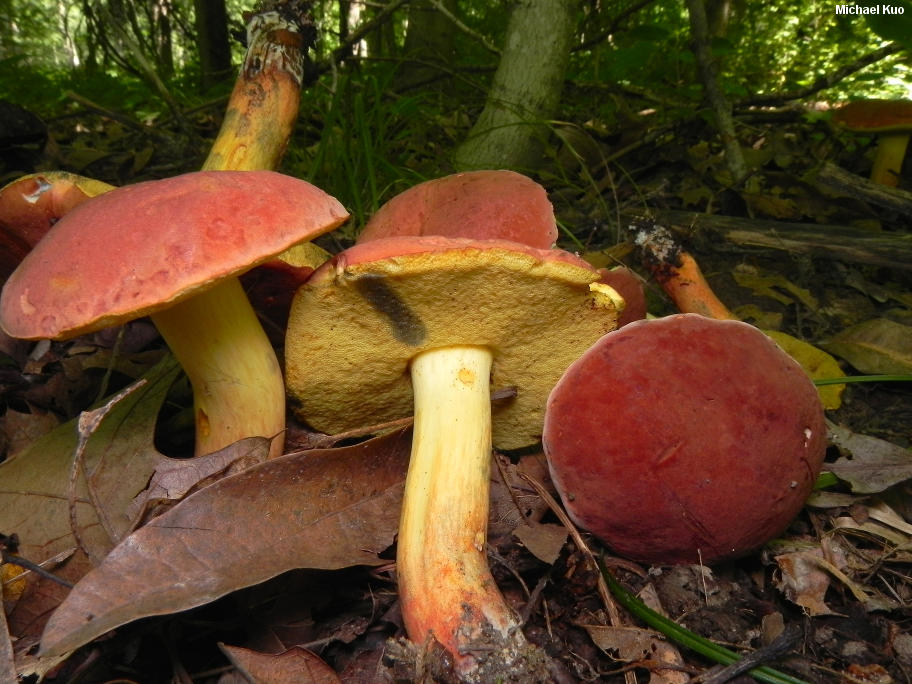
Boletus pseudosensibilis is a large mushroom featuring a reddish cap and a yellowish, thick stem. It is commonly found near oak trees in upland hardwood forests.
The boletus mushroom’s cap ranges from red to reddish-brown, with a rounded shape. Its thick stem is yellowish and smooth, and both the cap and stem contain yellow flesh. Boletus pseudosensibilis grows between 2.3 and 4 inches (6 to 10 cm) tall, with a cap diameter of 1.5 to 6 inches (4 to 16 cm).
Red mushroom identification
The identifying features of Boletus pseudosensibilis are its rusty-red or red-brown cap and yellowish, meaty stem.
Two-Colored Bolete Mushroom (Boletus bicolor)
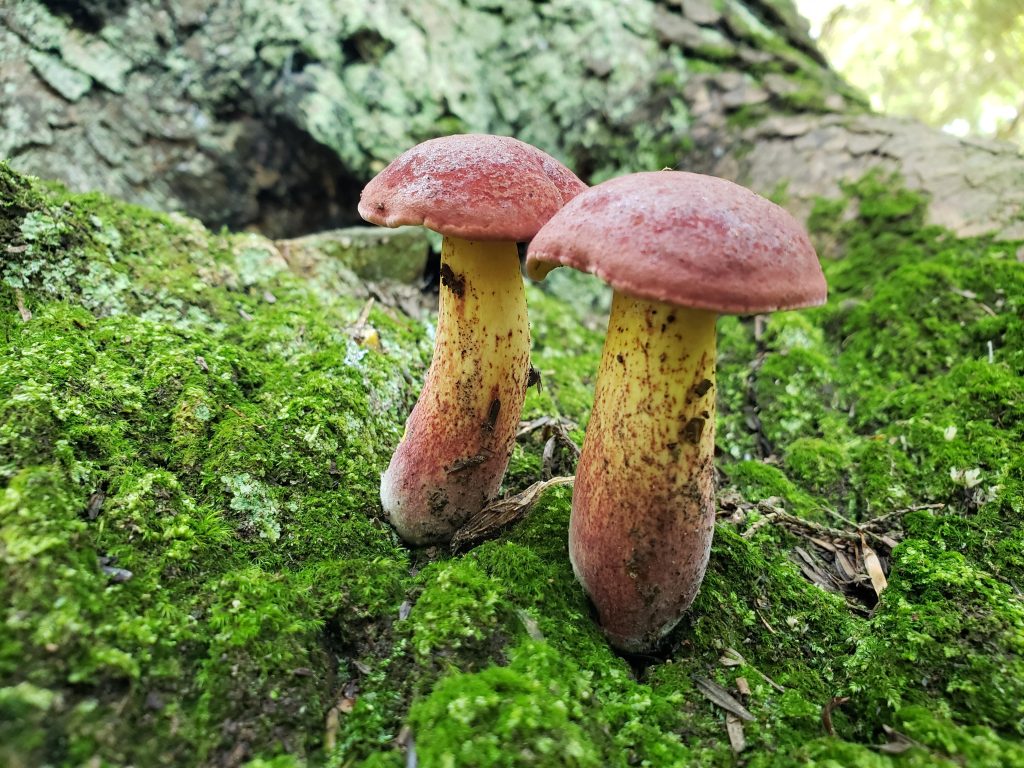
The two-colored bolete mushroom stands out due to its pink-reddish cap and yellow underside. It can be found in hardwood forests.
This vibrant, edible mushroom displays a broad, convex smooth cap ranging from bright red to brown. Its thick, spongy stem is pinkish-red or brown. However, when cut open, the mushroom reveals yellowish flesh.
The two-colored bolete mushroom grows between 2 and 6 inches (5 to 15 cm) tall, with a round, convex red cap measuring 1.5 to 6.2 inches (4 to 16 cm) in width.
Red mushroom identification
The two-colored bolete mushroom is easily identified by its vibrant red cap with a yellow underside, lacking the presence of gills.
Frost’s Bolete Mushroom (Butyriboletus frostii)
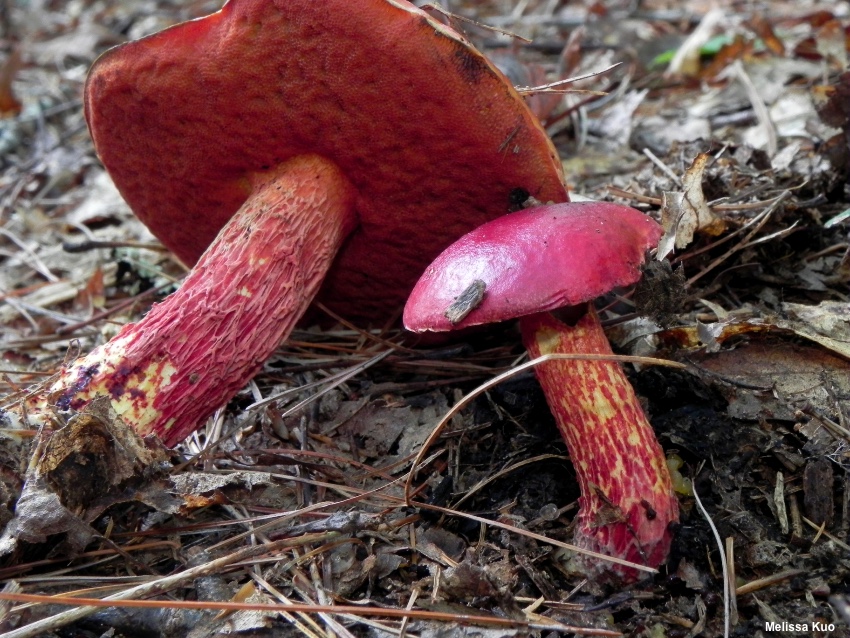
Frost’s bolete mushroom is recognized by its deep red cap and textured red stem. It is commonly found near oak trees.
The pure red cap of Frost’s bolete is easily recognizable on woodland floors. It features a slightly rounded, oval shape with a smooth, sticky surface. The coarsely reticulated stems exhibit network-like patterns, similar to morel mushrooms. Cutting into this deep red mushroom reveals whitish to yellowish flesh.
Frost’s bolete mushroom grows between 1.5 and 3.1 inches (4 to 8 cm) tall, with a disc-shaped cap measuring 1.3 to 3.1 inches (3.5 to 8 cm) in diameter.
Red mushroom identification
Frost’s bolete is distinct from other bolete mushrooms due to its deep red color, rather than reddish-brown or rusty red hues.
Crepidotus cinnabarinus
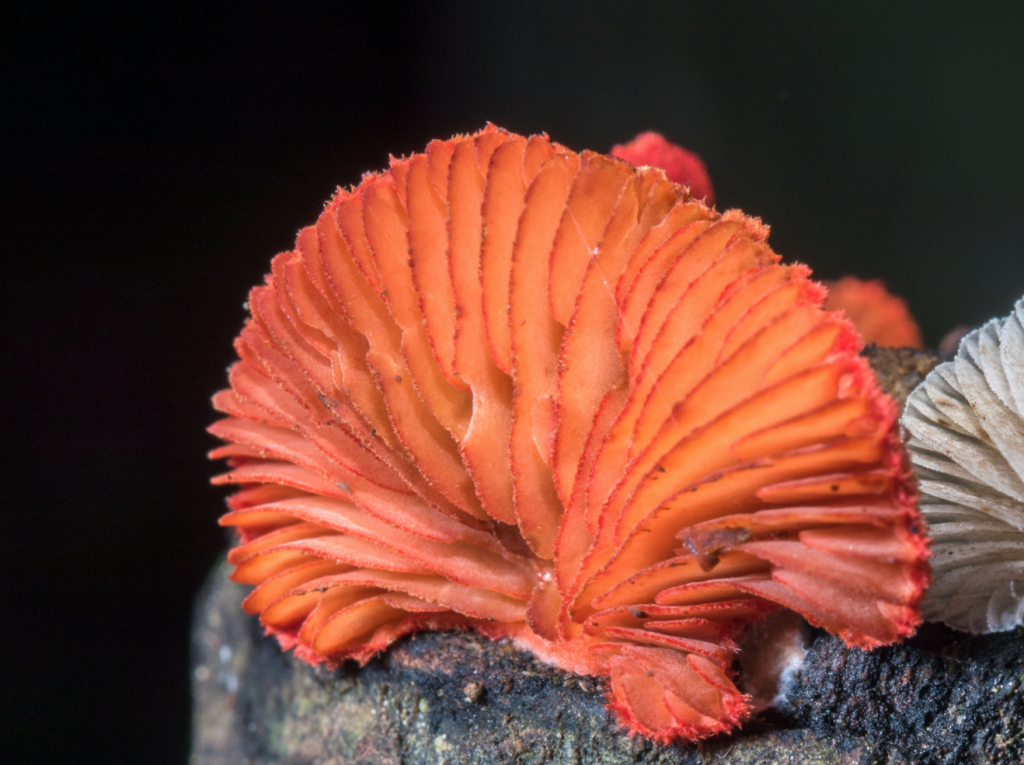
Crepidotus cinnabarinus is an unusual orange-red mushroom that resembles a red shell. Its gills are pronounced and reddish-orange. This
small mushroom, measuring between 0.07 and 0.7 inches (0.2 to 1.8 cm), can be found growing on decaying deadwood.
Red mushroom identification
Crepidotus cinnabarinus is easily identified by its shell-like shape, appearing as small reddish-orange fans on decaying deadwood.
Cortinarius marylandensis
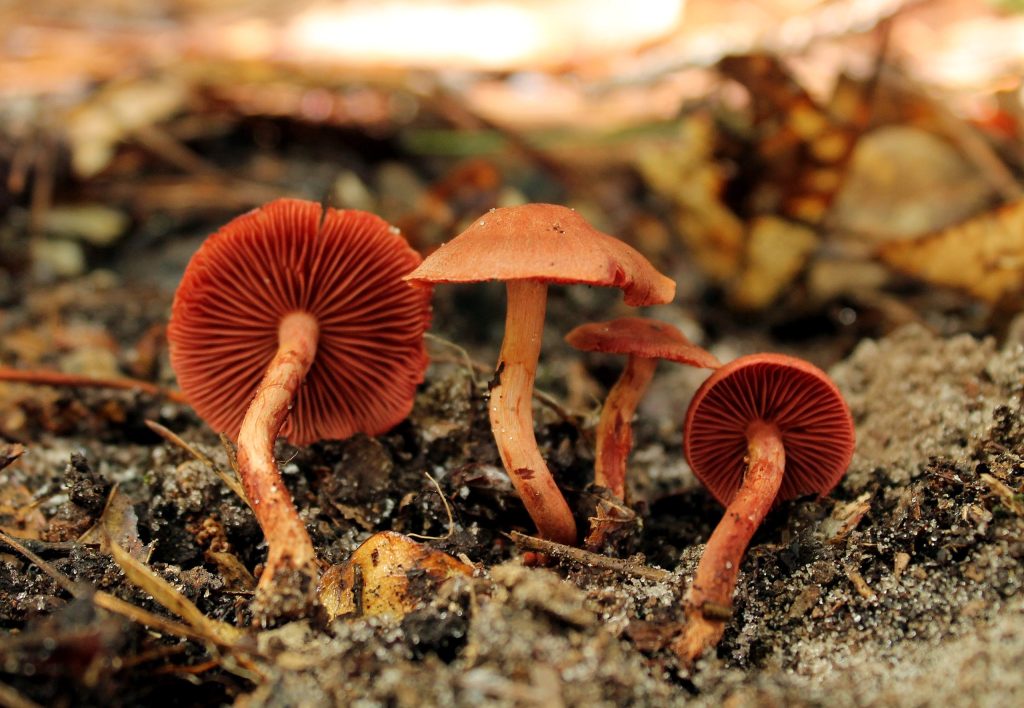
Cortinarius marylandensis is a striking red mushroom with blood-red gills. This fungi species features a rusty-red stem, a relatively small convex or bell-shaped red cap, and a cylindrical stem. It can be found in hardwood woodlands throughout eastern North America.
The deep red-colored mushroom grows between 0.78 and 2 inches (2 to 5 cm) tall, with its bell-shaped cap measuring between 0.39 and 1.5 inches (1 to 4 cm) in diameter.
Red mushroom identification
Cortinarius marylandensis is a small bright red mushroom with a broadly oval bell-like cap.
